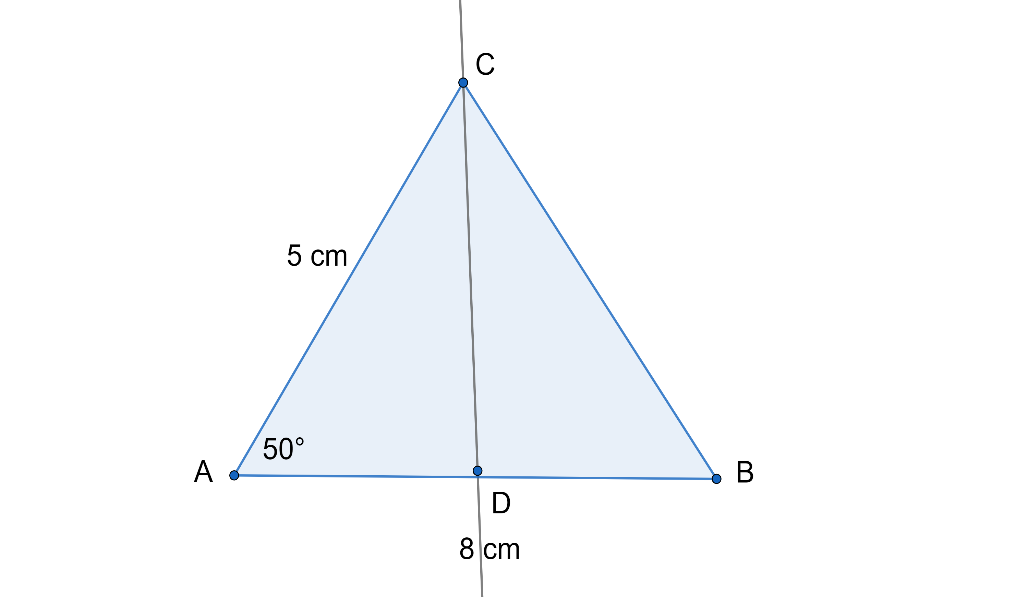Question
Question: In \(\Delta ABC\), \(AB=8cm\), \(AC=5cm\) and \(\angle A=50{}^\circ \). Then (a) What is the lengt...
In ΔABC, AB=8cm, AC=5cm and ∠A=50∘. Then
(a) What is the length of the perpendicular from C to AB?
(b) Find the length of BC.
[sin50∘=0.7660,cos50∘=0.6428,tan50∘=1.1918]
Solution
Hint:We have to find the length of CD and BC. For that consider ΔACD and take sinA. Then substitute the values, you will get CD. Now, for BCconsider cosAand find the value of AD. Prove the ΔACD and ΔCDB congruent and then from that AD=BD. After that, consider ΔCDB and use pythagora's theorem to find length of BC. Try it, you will get the answer.
Complete step-by-step answer:
A triangle is a polygon with three edges and three vertices. It is one of the basic shapes in geometry. A triangle with vertices A, B, and C is denoted ΔABC.
In Euclidean geometry, any three points, when non-collinear, determine a unique triangle and simultaneously, a unique plane (i.e. a two-dimensional Euclidean space). In other words, there is only one plane that contains that triangle, and every triangle is contained in some plane. If the entire geometry is only the Euclidean plane, there is only one plane and all triangles are contained in it; however, in higher-dimensional Euclidean spaces, this is no longer true. This article is about triangles in Euclidean geometry, and in particular, the Euclidean plane, except where otherwise noted.
The sum of the measures of the interior angles of a triangle in Euclidean space is always 180∘. This fact is equivalent to Euclid's parallel postulate. This allows determination of the measure of the third angle of any triangle given the measure of two angles. An exterior angle of a triangle is an angle that is a linear pair (and hence supplementary) to an interior angle. The measure of an exterior angle of a triangle is equal to the sum of the measures of the two interior angles that are not adjacent to it; this is the exterior angle theorem. The sum of the measures of the three exterior angles (one for each vertex) of any triangle is 360∘.

In the above figure, let CD perpendicular to AB.
Now in ΔACD,
sinA=ACCD
Now, substituting the values we get,
sin50∘=5CD
CD=sin50∘×5CD=0.7660×5
CD=3.83cm
Also,
cosA=ACAD
Now, substituting the values we get,
cos50∘=5ADcos50∘×5=ADAD=0.6428×5
AD=4.786cm
Now in right angle ΔACD,
∠A=50∘ and ∠CDA=90∘
So ∠C=180∘−(∠A+∠CDA)=180∘−(50∘+90∘)=180∘−140∘=40∘
∠C=40∘
Similarly, in ΔCDB,
We get, ∠B=40∘
So in ΔACD and ΔCDB,
∠B=∠C=40∘ and ∠CDA=∠CDB=90∘
Therefore, ΔACD≅ΔCDB ………………….. (AA similarity)
Since, ΔACD≅ΔCDB
AD=DB=4.786cm
Now in right angle ΔCDB,
by Pythagoras theorem,
BC2=CD2+DB2
So substituting the values we get,
& B{{C}^{2}}={{(3.83)}^{2}}+{{(4.786)}^{2}} \\\ & B{{C}^{2}}=14.61+22.61 \\\ & B{{C}^{2}}=37.58 \\\ \end{aligned}$$ $BC=\sqrt{37.58}cm$ Therefore, we get the length of perpendicular $CD$ and length of $BC$as $3.83cm$ and $\sqrt{37.58}cm$ respectively. Note: Read the question in a careful manner. Also you must know the basic concepts related to triangles and its properties. Do not make any silly mistakes. Also, take care that while simplifying no confusion occurs. Don’t jumble yourself while simplifying the problem.